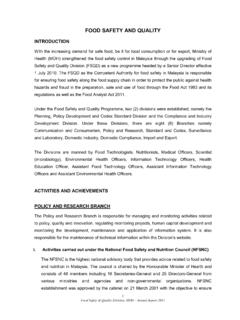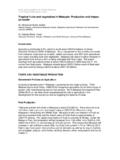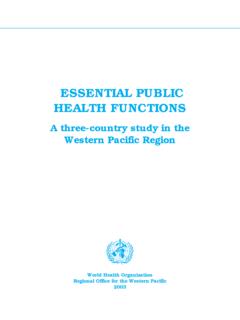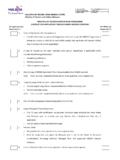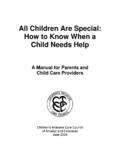Transcription of 02.Layout 4/26/11 9:55 AM Page 1
1 4/26/11 9:55 AM Page 12| Guide To Nutrition Labelling and Claims (as at December 2010)CHAIRMANDr Tee E SiongNutrition ConsultantMEMBERSMs Zalma Abd RazakMrJa afar Mohamed IdrisNutrition DivisionMinistry of health MalaysiaProf Christopher BoeyPaediatric DepartmentUniversity Malaya Medical CentreMs Siti Hawa Mohd TaibDietetic DepartmentUniversity Malaya Medical Centre Dr Ngu Lock HockPaediatric DepartmentGeneral Hospital, Kuala LumpurMs Mageswary a/p LapchmananDietetic Department, Selayang HospitalMs Salasiah AbdullahMsChow Guan KuanNational Pharmaceutical Control BureauMs Umi Kalsum Hussain ZakiFood Technology Centre,MARDIMs Zalifah Mohd KassimFaculty of Science and Technology,Universiti Kebangsaan MalaysiaEXPERT COMMITTEE ON NUTRITION, health CLAIMS AND ADVERTISEMENTA ssoc.
2 Prof. Dr Poh Bee KoonAssoc. Prof. Dr Tilakavati KarupaiahFaculty of Nutrition and Dietetic, Universiti Kebangsaan MalaysiaDr Azrina AzlanFaculty of Medicine and health Science,Universiti Putra MalaysiaDr Faridah AbasFaculty of Science and Food Technology,Universiti Putra MalaysiaMs Norhayati Mustafa KhalidInstitute for Medical ResearchMs Norhayati ZakariaDepartment of Chemistry, MalaysiaMr Mohd Mokmin BahariMalaysian Palm Oil BoardMs Norrani EksanMs Fatimah SulongMs Raizawanis Abdul RahmanMs Har Rasyidah Mohamad IraniFood Safety and Quality Division, ministry of health , MalaysiaDisclaimer:This guidance is not legally binding and should therefore be read togetherwith the relevant national legislation. For legal interpretations of the proposed regulations,the reader should always rely on the gazettes to be published and on the advice of theirlegal 4/26/11 9:55 AM Page 2 Guide To Nutrition Labelling and Claims (as at December 2010) | 3 Foreword04 Introduction05 Codex Alimentarius06 Regulation of Nutrition Labelling & Claims in Malaysia08 Applying for Amendments11 Nutrition Labelling11 Nutrition Claims21 APPENDICES Appendix 1: Application for Addition to Permitted Added Nutrient List32 Appendix 2: Application for Nutrition Claims 34 Appendix 3: Application for Addition to NRV List36 Appendix 4: List of Nutrient Reference Values (NRV)37 Appendix 5: Calculation Aids37 Appendix 6: Conversion Factor for Nitrogen to Protein37 Appendix 7.
3 Conditions for Nutrient Content Claims for Low in or Free of 38 Appendix 8 : Conditions for Nutrient Content Claims for Source of or High in 39 Appendix 9 : Other Conditions for Nutrient Function Claims40 Appendix 10 : Criteria for Compliance According to 4/26/11 9:55 AM Page 34| Guide To Nutrition Labelling and Claims (as at December 2010)FOREWORDOver 25 years ago, ministry of health enacted the Food Act 1983, followed by Food Regulations1985 with the main objectives of protecting the public against health hazards in food and fraud inthe preparation, sale and use of foods. Over the years, numerous amendments have been made tothese regulations, in response to global regulatory developments, requests of the food industry andconsumer needs. One of such developments was the enactment of regulations for mandatorynutrition labelling and nutrition claims in 2003.
4 The key focus of these regulations is to enablemanufacturers to emphasise the nutritional properties of a food product, thereby guiding theconsumers in making better food the enactment of these regulations, several amendments have been made, in keeping withthe needs of all stakeholders. In amending these regulations, our emphasis has always been tomake decisions based on the most up-to-date scientific evidence available locally or have also recognised that the regulations must be practical and not impose additional costs onfood manufacturers which may eventually have to be borne by the consumers. We believe thatregulations should be clear, consistent and fair, giving businesses confidence to make long terminvestments, while effective in safe-guarding consumer has been the practice of the ministry of health to enact regulations in full consultation with allstakeholders.
5 We would like to further invite comments and feedback from all stakeholders todetermine if further legislative changes are required in order to ensure they meet the needs of theconsumers. To ensure that these regulations meet the objectives of helping consumers make foodchoices, further efforts are required to education consumers on the appropriate use of suchnutrition information on food labels. I would also like to take this opportunity to call on the foodindustry to fully comply with these regulations. Ms Noraini Dato Mohd OthmanSenior Director for Food Safety and Quality ministry of health 4/26/11 9:55 AM Page 4 Guide To Nutrition Labelling and Claims (as at December 2010) | 5 INTRODUCTIONThe primary objective of nutrition labelling and claims is to describe the nutritional qualities of afood product factually and informatively, thereby assisting the consumer in making better foodchoices when planning their daily meals.
6 Such nutrition information on food labels is equallyimportant to the food industry as it provides a means for food manufacturers and retailers tobecome more aware of the nutritional properties of their products and be encouraged toemphasise these properties to consumers. Food manufacturers have a social responsibility tocontribute positively to the healthy lifestyle programmes of the health authorities. In cognizance of the above, the ministry of health Malaysia has gazetted and enforced Regulationson Nutrition Labelling and Claims. Nutrition labelling describes the nutrient content of the foodproduct. The nutrients are declared as a table in one section of a food label, commonly known asa nutrition information panel (NIP).
7 As for the claims, three (3) types on nutrition claims arepermitted in Malaysia, namely nutrient content claim, nutrient comparative claim and nutrientfunction claim. The Regulations on Nutrition Labelling and Claims were drafted by the Expert Committee onNutrition, health Claims and Advertisement. Members of the Committee comprise nutritionists,dieticians, medical doctors and food scientists from various departments and agencies and theacademia. The Committee had received and reviewed numerous applications from the foodindustry, particularly for new nutrient function claims. Recognising the importance of other foodcomponents to human health , several such claims have been approved based on scientific findingssubmitted by the applicants.
8 A system has been established to consider applications from the industry for such claims, as well asother proposals to amend these regulations. Instruction for submitting applications, the formrequired and the conditions to be met have been clearly stated. All proposals for amendment arealso subjected to public comments before final view of the numerous amendments made to the regulations, it is essential to update this Guideto Nutrition Labelling and Claims that was first published in 2005 and updated in 2007. The currentedition compiles all the nutrient function claims as well as other related amendments since 2003till the end of December 2010. It is hoped that this Guide will be able to assist the food industry,the regulatory authorities, all related professionals and the consumers in the understanding andapplication of the regulations.
9 Dr Tee E SiongChairman,Expert Committee on Nutrition, health Claims and AdvertisementMinistry of health 4/26/11 9:55 AM Page 56| Guide To Nutrition Labelling and Claims (as at December 2010)CODEX ALIMENTARIUSTHE NEED FOR AN INTERNATIONAL FOOD CODEFood laws are not a 21st-century invention. Even in ancient civilisations, rules and systems existedtoensure fair trade practices as well as food quality and safety for the people. In the same tradition,different countries began developing their own food standards, towards the early , different sets of standards gave rise to trade barriers, as governments were wary ofimporting food from countries that had different food standards. The situation demanded for agood code that would harmonise food laws from all countries and allow manufacturers to exporttheir products ALIMENTARIUSIn 1962, the Food and Agriculture Organization (FAO) and the World health Organization (WHO)established the Codex Alimentarius Commission and implemented a joint FAO/WHO foodstandards programme.
10 The main objectives of Codex Alimentarius Commission are:a)Protecting the health of the consumers and ensuring fair practices in the food trade;b) Promoting coordination of all food standards work undertaken by international governmental and non-governmental organizations;c) Amending published standards, as appropriate, in the light of Commission finalizes food standards and codes, and compiles them into an internationalreference known as the Codex Alimentarius. To date, the Codex Alimentarius comprises foodstandards, guidelines and code of practices for a wide variety of food commodities, food labelling,food hygiene, food additive, pesticide residues, contaminant and veterinary drug in international body, the Commission has 184 member countries including EuropeanCommunity (as of 31 December 2010).

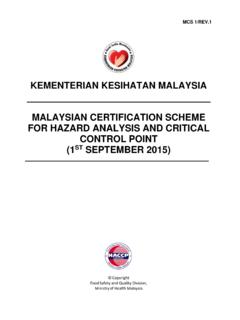
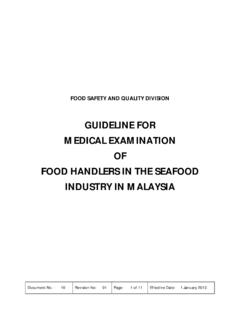


![FIRST SCHEDULE 162/88, 90/99,318/12] - …](/cache/preview/5/9/4/f/4/0/6/1/thumb-594f4061e61fbd66812936804bf1f548.jpg)
